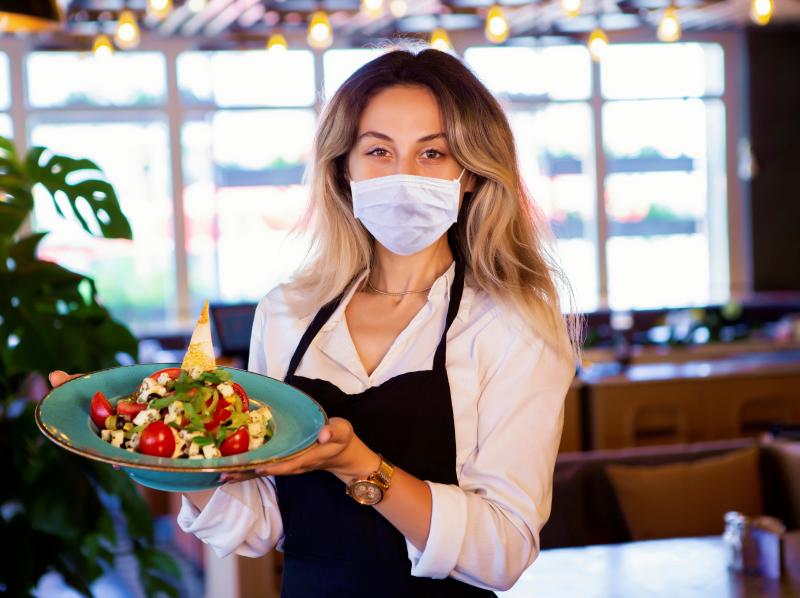This is what restaurants must do before reopening May 18
Restaurants in 12 of Maine’s 16 counties can reopen for business beginning Monday, May 18 so long as they follow a set of guidelines appearing below.
Under the newly released plan by Governor Janet Mills, restaurants will be permitted to open in-store dining operations, with enhanced safety precautions, in counties where community transmission is not present.
Those counties are Aroostook, Piscataquis, Washington, Hancock, Somerset, Franklin, Oxford, Kennebec, Waldo, Knox, Lincoln, and Sagadahoc.
Employees
• Require employees to wear cloth face coverings and practice good hand hygiene. It is acceptable for kitchen staff to wear face shields in lieu of masks when the kitchen or weather is warm.
• Good hand hygiene prevents spread of disease. The best hand hygiene is frequent handwashing. Remind employees to practice good hand hygiene with frequent handwashing and hand sanitizing especially between contact with customers and customer items.
• Gloves are not a replacement for good hygiene. If you wear gloves, change them frequently and wash between customers and activities.
• Hand sanitizer may not be used in place of handwashing for food production.
• Where possible, stagger employee shifts and meal breaks to avoid crowding in common work areas.
• Ensure employees stay 6 feet apart whenever practical.
• Adjust seating in break rooms and other common areas to reflect physical distancing practices.
• Prohibit gatherings or meetings of employees of 10 or more during working hours.
• Permit employees to take breaks and lunch outside, or in such other areas where physical distancing is attainable.
• Do not allow employee food or drink in food service areas.
• Limit interaction between employees and outside visitors or delivery drivers; implement touchless receiving practices if possible.
• Adjust training and new employee orientation to limit number of people involved and allow for six foot spacing; use virtual/video/audio training when possible.
• Limit sharing of handheld equipment, phones, desks, workstations, and other tools and equipment between employees to the extent possible.
• Provide employee training for:
o physical distancing guidelines and expectations
o monitoring personal health
o proper wear, removal, disposal of Personal Protective Equipment (PPE)
o laundering of face coverings and uniforms as listed below
o cleaning protocols as listed below
o how to monitor personal health and body temperature at home
o guidance on how to launder cloth face coverings and uniforms: see CDC, Cleaning and Disinfecting Your Facility, How to Disinfect: Laundry
o cleaning protocol, including how to safely and effectively use cleaning supplies.
• Consider employee training in safe de-escalation techniques.
• Entertainment personnel should follow the same physical distancing and cloth face covering guidelines as other employees.
Customers
• Inform your customers of your COVID policies and procedures in advance, if possible.
• Place signage at entrances and throughout the store alerting customers to COVID policies, especially to maintain 6 feet physical distance to the extent possible.
• Consistent with Executive Order 49 FY 19/20, customers should wear cloth face coverings when in a food service facility where social distancing is difficult (e.g., waiting in line for pickup, entering or exiting, walking to the restrooms). Customers do not need to wear face coverings when seated at the table.
• Use reservations with call ahead or online as a best practice.
• Establishments may call, use a text alert or intercom system to alert guests that their table is ready. Only one member of a party may wait inside in the waiting area and must remain at least six feet apart.
• Avoid crowding at restaurant entrance and maintain physical distancing in any waiting line.
• Maintain physical distancing protocols during guest check-in and seating.
• Communicate to customers that they should not come to the restaurant if they have a fever or cough.
• Consider offering exclusive early hours to seniors and other high-risk individuals.
• Consider adjusting store hours of operation, as necessary, to support social distancing efforts by limiting number of customers at one time.
• Minimize customer and staff interactions by assigning wait staff to ‘areas’ and tables. If possible, keep staff work groups to same days/shifts to minimize staff exposures.
• For contact tracing purposes, maintain records of customers, including one customer name and contact information per party and the server of the table, for at least 21 days.
• Limit restroom occupancy for group restrooms to incorporate physical distancing and avoid formation of waiting lines outside of restrooms.
• Menus should be laminated or plastic covered and sanitized after each use, or single use paper.
• Continue take out, curbside and delivery with beer, wine and cocktails.
• Maximum group party size of eight people.
• Dining room tables should be spaced at least six feet apart.
• The total number of people any one time should be no more than 50 people per room and each party must be six feet apart from other parties. This also applies to outdoor seating areas. Have a back-up plan for outdoor seating that adheres to physical distance requirements in case of inclement weather.
• Bar or counter service within restaurant establishments must follow physical distance guidelines. Provide physical barriers to protect customers and wait staff such as partitions or plexiglass barriers or face coverings plus face shields for staff if there is not six feet of distance between customers and counter staff.
• Establishments where counter service is combined with liquor service must also take measures to ensure customers do not congregate at the counter.
• Bar areas within restaurants must close at the same time the kitchen closes for dining patrons.
• Where practical, especially in booth seating, physical barriers are acceptable.
• Use EPA-approved cleaning and disinfectant products to wipe down dining room tables and chairs after each party.
• Provide only single use condiments at this time.
• Suspend salad bars buffets at this time.
• Minimize other self-service areas such as drink stations. To the extent possible, use contact-less dispensers to minimize hand touching. Replace multi-use condiments with single-serve packets. Other suggestions to minimize multi-touch surfaces include providing single-wrap utensils, straws, and lids provided at any take-out or self-seating point of sale. Self-service areas require frequent cleaning and disinfection.
• Allow expanded seasonal outdoor dining, with distancing protocols, in parking lots, sidewalks and expanded patios, etc.
• Use disposable napkins and table covers instead of cloth linens. If cloth linens are used, change between customers.
• Children need to remain seated with their party. No play areas or shared toys; single use crayons only.
Operations
• Consider ways to maximize air flow, if practical, to increase fresh air circulation (e.g., opening screened windows, or doors).
• Widen high-traffic areas to the extent possible.
• Note that staff or customer use of elevators or escalators will require regular attention to physical distance guidelines and frequent cleaning of high-touch surfaces.
• Minimize shared touch surfaces such as kiosks, tablets, pens, credit cards, receipts and keys.
• Establish protocols for regular disinfection and handling of received material shipments and inventoried materials.
• Establish protocols for handling and processing shipping and receipts (including disinfection).
• Advise contractors, drivers, and vendors that they are required by Executive Order #49 to wear cloth face coverings while on the premises.
• Notify vendors of re-opening, and any revised protocol as it relates to store entry, deliveries, paperwork, etc.
• Consider implementing measures to ensure vendor safety, including:
o Disabling/suspending access (e.g., suspending all non-employee delivery drivers from entering restaurant).
o Transitioning to contactless signatures/e-signatures for deliveries.
o Where practical, adjusting store delivery times to spread out deliveries.
• Request that vendors direct their employees to follow all social distancing guidelines and health directives issued by the applicable public authorities.
• Require regular and frequent sanitization of high-touch areas like restrooms, handrails, doors, PIN pads, and common areas that are accessible to staff, customers, and suppliers.
• Ensure operating hours allow downtime between shifts for thorough cleaning.
• Provide sanitization materials, such as sanitizing wipes, to employees to clean handhelds/wearables or other work tools and equipment before/after use.
• Consider providing cleaning “kits” including disinfectant wipes or sprays, disposable gloves, paper towels, cloth face coverings, hand sanitizer and other cleaning supplies that are readily accessible throughout the restaurant for areas that will be cleaned periodically throughout the day.
• Note the focus areas of cleaning include:
o Door and drawer handles
o Light and other power switches (consider signage to keep lights on at all times, or utilizing exiting motion sensor capabilities)
o Shared tools
o Chairs, tables, and benches
o Refrigerators, microwave, and other frequently touched objects and surfaces in service areas
o Time clocks
o Entry way
o Cash register, including touch screens, keyboards, mouse
o PIN Pads (touch screen, keypad, and pen)
o Restrooms (toilet bowl, toilet paper holder, flush lever, sinks and faucets, paper towel holders and/or air dryers and diaper-changing stations)
• Utensils and dishes used by customers should be treated as potentially contaminated and should be handled carefully. Wash hands after busing tables and handling used tableware.
• Note that vending machines are not recommended at this time due to the challenge of keeping surfaces clean.
• Provide hand sanitizer for customers and employee use, including restaurant entrance.
Sales
• Promote “Contactless” payment options:
o On-line shopping
o Contactless payment options (e.g., RFID credit and debit cards, Apple Pay, Google Pay, etc.)
o Self-checkout
o Pickup and delivery services
• Wash hands or use alcohol-based hand sanitizer (at least 60% alcohol) after handling cash.
• Consider increasing pickup hours to serve more online customers.
• Consider adding physical barriers such as partitions or plexiglass barriers at registers.
• Restaurants vary significantly in terms of size, models, such as wait service, self-service, counter and window service, take-out, as well as types of seating arrangements. In all cases, take appropriate steps to minimize risk to customers and employees through effective physical distancing, attention to hand hygiene, and facial coverings.
Event Date
Address
United States





























